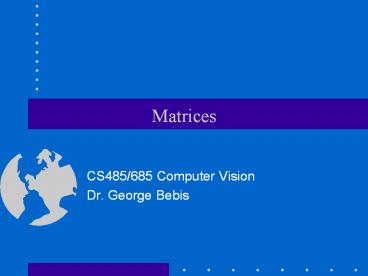Matrices - PowerPoint PPT Presentation
Title:
Matrices
Description:
Matrix multiplication Condition: n = q m x n q x p m x p Identity Matrix Matrix Transpose Symmetric Matrices Example: Determinants 2 x 2 3 x 3 n x n Determinants ... – PowerPoint PPT presentation
Number of Views:273
Avg rating:3.0/5.0
Title: Matrices
1
Matrices
- CS485/685 Computer Vision
- Dr. George Bebis
2
Matrix Operations
- Matrix addition/subtraction
- Matrices must be of same size.
- Matrix multiplication
m x n
q x p
m x p
Condition n q
3
Identity Matrix
4
Matrix Transpose
5
Symmetric Matrices
Example
6
Determinants
2 x 2
3 x 3
n x n
7
Determinants (contd)
diagonal matrix
8
Matrix Inverse
- The inverse A-1 of a matrix A has the property
- AA-1A-1AI
- A-1 exists only if
- Terminology
- Singular matrix A-1 does not exist
- Ill-conditioned matrix A is close to being
singular
9
Matrix Inverse (contd)
- Properties of the inverse
10
Pseudo-inverse
- The pseudo-inverse A of a matrix A (could be
non-square, e.g., m x n) is given by - It can be shown that
11
Matrix trace
properties
12
Rank of matrix
- Equal to the dimension of the largest square
sub-matrix of A that has a non-zero determinant. - Example
has rank 3
13
Rank of matrix (contd)
- Alternative definition the maximum number of
linearly independent columns (or rows) of A.
Therefore, rank is not 4 !
Example
14
Rank and singular matrices
15
Orthogonal matrices
- Notation
- A is orthogonal if
Example
16
Orthonormal matrices
- A is orthonormal if
- Note that if A is orthonormal, it easy to find
its inverse
Property
17
Eigenvalues and Eigenvectors
- The vector v is an eigenvector of matrix A and ?
is an eigenvalue of A if - Interpretation the linear transformation implied
by A cannot change the direction of the
eigenvectors v, only their magnitude.
(assume non-zero v)
18
Computing ? and v
- To find the eigenvalues ? of a matrix A, find the
roots of the characteristic polynomial
Example
19
Properties
- Eigenvalues and eigenvectors are only defined for
square matrices (i.e., m n) - Eigenvectors are not unique (e.g., if v is an
eigenvector, so is kv) - Suppose ?1, ?2, ..., ?n are the eigenvalues of A,
then
20
Properties (contd)
xTAx gt 0 for every
21
Matrix diagonalization
- Given A, find P such that P-1AP is diagonal
(i.e., P diagonalizes A) - Take P v1 v2 . . . vn, where v1,v2 ,. . . vn
are the eigenvectors of A
22
Matrix diagonalization (contd)
Example
23
Are all n x n matrices diagonalizable?
- Only if P-1 exists (i.e., A must have n linearly
independent eigenvectors, that is, rank(A)n) - If A has n distinct eigenvalues ?1, ?2, ..., ?n ,
then the corresponding eigevectors v1,v2 ,. . .
vn form a basis - (1) linearly independent
- (2) span Rn
24
Diagonalization ? Decomposition
- Let us assume that A is diagonalizable, then
25
Decomposition symmetric matrices
- The eigenvalues of symmetric matrices are all
real. - The eigenvectors corresponding to distinct
eigenvalues are orthogonal.
P-1PT































